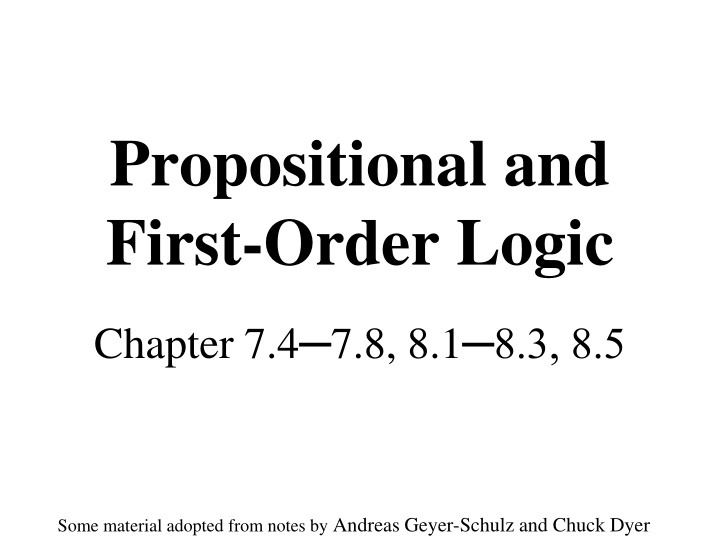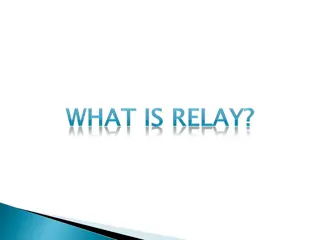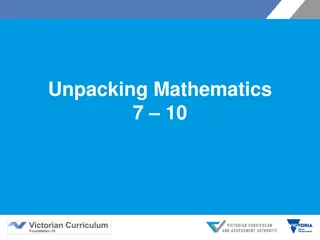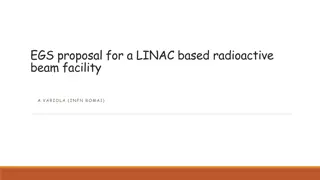
Foundations of Propositional and First-Order Logic: A Deep Dive
Delve into the intricate realms of propositional and first-order logic, exploring logical constants, symbols, connectives, and semantic interpretations. Uncover the power of logical agents, situation calculus, and goal-based agents in representing and solving AI problems. Discover the essence of knowledge representation languages and the expressive capabilities of first-order logic in the field of artificial intelligence.
Download Presentation

Please find below an Image/Link to download the presentation.
The content on the website is provided AS IS for your information and personal use only. It may not be sold, licensed, or shared on other websites without obtaining consent from the author. If you encounter any issues during the download, it is possible that the publisher has removed the file from their server.
You are allowed to download the files provided on this website for personal or commercial use, subject to the condition that they are used lawfully. All files are the property of their respective owners.
The content on the website is provided AS IS for your information and personal use only. It may not be sold, licensed, or shared on other websites without obtaining consent from the author.
E N D
Presentation Transcript
Propositional and First-Order Logic Chapter 7.4 7.8, 8.1 8.3, 8.5 Some material adopted from notes by Andreas Geyer-Schulz and Chuck Dyer
Logic roadmap overview Propositional logic (review) Problems with propositional logic First-order logic (review) Properties, relations, functions, quantifiers, Terms, sentences, wffs, axioms, theories, proofs, Extensions to first-order logic Logical agents Reflex agents Representing change: situation calculus, frame problem Preferences on actions Goal-based agents
Disclaimer Logic, like whiskey, loses its beneficial effect when taken in too large quantities. - Lord Dunsany
Propositional Logic: Review
Big Ideas Logic is a great knowledge representation language for many AI problems Propositional logic is the simple foundation and fine for many AI problems First order logic (FOL) is much more expressive as a KR language and more commonly used in AI There are many variations: horn logic, higher order logic, three-valued logic, probabilistic logics, etc.
Propositional logic Logical constants: true, false Propositional symbols: P, Q,... (aka atomic sentences) Wrapping parentheses: ( ) Sentences are combined by connectives: and or implies is equivalent not Literal: an atomic sentence or negated atomic sentence: P, P [conjunction] [disjunction] [implication / conditional] [biconditional] [negation]
Examples of PL sentences (P Q) R If it is hot and humid, then it is raining Q P If it is humid, then it is hot Q It is humid. We re free to choose better symbols, btw: Ho = It is hot Hu = It is humid R = It is raining
Some terms The meaning or semantics of a sentence determines its interpretation Given the truth values of all symbols in a sentence, it can be evaluated to determine its truth value (True or False) A model for a KB is a possible world an assignment of truth values to propositional symbols that makes each sentence in the KB True
Model for a KB Let the KB be [P Q R, Q P] What are the possible models? Consider all possible assignments of T|F to P, Q and R and check truth tables PQR FFF: OK FFT: OK FTF: NO FTT: NO TFF: OK TFT: OK TTF: NO TTT: OK If KB is [P Q R, Q P, Q], the only model is TTT P: it's hot Q: it's humid R: it's raining
More terms A valid sentence or tautologyis a sentence that s True under all interpretations, no matter what the world is actually like or what the semantics is. Example: It's raining or it's not raining An inconsistent sentence or contradiction is a sentence that s False under all interpretations. The world is never like what it describes, as in It's raining and it's not raining. P entails Q, written P |= Q, means that whenever P is True, so is Q In all models in which P is true, Q is also true
Truth tables Truth tables are used to define logical connectives And to determine when a complex sentence is true given the values of the symbols in it Truth tables for the five logical connectives Example of a truth table used for a complex sentence
On the implies connective: P Q is a logical connective So P Q is a logical sentence and has a truth value, i.e., is either true or false If we add this sentence to a KB, it can be used by an inference rule, Modes Ponens, to derive/infer/prove Q if P is also in the KB Given a KB where P=True and Q=True, we can also derive/infer/prove that P Q is True
P Q When is P Q true? Check all that apply P=Q=true P=Q=false P=true, Q=false P=false, Q=true
P Q When is P Q true? Check all that apply P=Q=true P=Q=false P=true, Q=false P=false, Q=true We can get this from the truth table for Note: in FOL it's much harder to prove that a conditional true Consider proving prime(x) odd(x)
Inference rules Logical inference creates new sentences that logically follow from a set of sentences (KB) An inference rule is sound if every sentence X it produces when operating on a KB logically follows from the KB i.e., inference rule creates no contradictions An inference rule is complete if it can produce every expression that logically follows from (is entailed by) the KB. Note analogy to complete search algorithms
Sound rules of inference Here are examples of sound rules of inference Each can be shown to be sound using a truth table RULE PREMISE Modus Ponens A, A B And Introduction A, B And Elimination A B Double Negation A Unit Resolution A B, B Resolution A B, B C CONCLUSION B A B A A A A C
Resolution Resolution is a valid inference rule producing a new clause implied by two clauses containing complementary literals A literal is an atomic symbol or its negation, i.e., P, ~P Amazingly, this is the only interference rule needed to build a sound & complete theorem prover Based on proof by contradiction and usually called resolution refutation The resolution rule was discovered by Alan Robinson (CS, U. of Syracuse) in the mid 1960s
Resolution A KB is actually a set of sentences all of which are true, i.e., a conjunction of sentences. To use resolution, put KB into conjunctive normal form (CNF) where each is a disjunction of (one or more) literals (positive or negative atoms) Every KB can be put into CNF, it's just a matter of rewriting its sentences using standard tautologies, e.g. P Q ~P Q
Resolution Example KB: [P Q , Q R S] KB in CNF: [~P Q , ~Q R , ~Q S] Resolve KB(1) and KB(2) producing: ~P R (i.e., P R) Resolve KB(1) and KB(3) producing: ~P S (i.e., P S) New KB: [~P Q , ~Q R, ~Q S, ~P R, ~P S] Tautologies (A B) (~A B) (A (B C)) (A B) (A C)
Soundness of the resolution inference rule From the rightmost three columns of this truth table, we can see that ( ) (~ ) ( ) is valid (i.e., always true regardless of the truth values assigned to , and
Proving things A proof is a sequence of sentences, where each is a premise (i.e., a given) or is derived from earlier sentences in the proof by an inference rule Last sentence is the theorem (also called goal or query) that we want to prove Example for the weather problem 1 Hu premise 2 Hu Ho premise 3 Ho modus ponens(1,2) 4 (Ho Hu) R premise 5 Ho Hu and introduction(1,3) It's hot and humid 6 R modus ponens(4,5) It's humid If it's humid, it'shot It's hot If it's hot & humid, it's raining It's raining
Horn* sentences A Horn sentence or Horn clause has the form: P1 P2 P3 ... Pn Qm where n>=0, m in{0,1} Note: a conjunction of 0 or more symbols to left of and 0-1 symbols to right Special cases: n=0, m=1: P (assert P is true) n>0, m=0: P Q (constraint: both P and Q can t be true) n=0, m=0: (well, there is nothing there!) Put in CNF: each sentence is a disjunction of literals with at most one non-negative literal P1 P2 P3 ... Pn Q (P Q) = ( P Q) * After Alfred Horn
Significance of Horn logic We can also have horn sentences in FOL Reasoning with horn clauses is much simpler Satisfiability of a propositional KB (i.e., finding values for a symbols that will make it true) is NP complete Restricting KB to horn sentences, satisfiability is in P For this reason, FOL Horn sentences are the basis for many rule-based languages, including Prolog and Datalog Horn logic gives up handling, in a general way, (1) negation and (2) disjunctions
Problems with Propositional Logic
Propositional logic: pro and con Advantages Simple KR language sufficient for some problems Lays the foundation for higher logics (e.g., FOL) Reasoning is decidable, though NP complete, and efficient techniques exist for many problems Disadvantages Not expressive enough for most problems Even when it is, it can very un-concise
PL is a weak KR language Hard to identify individuals (e.g., Mary, 3) Can t directly talk about properties of individuals or relations between individuals (e.g., Bill is tall ) Generalizations, patterns, regularities can t easily be represented (e.g., all triangles have 3 sides ) First-Order Logic (FOL) is expressive enough to represent this kind of information using relations, variables and quantifiers, e.g., Every elephant is gray: x (elephant(x) gray(x)) There is a white alligator: x (alligator(X) ^ white(X))
Hunt the Wumpus domain Some atomic propositions: S12 = There is a stench in cell (1,2) B34 = There is a breeze in cell (3,4) W22 = Wumpus is in cell (2,2) V11 = We ve visited cell (1,1) OK11 = Cell (1,1) is safe Some rules: S22 W12 W23 W32 W21 S22 W12 W23 W32 W21 B22 P12 P23 P32 P21 W22 S12 S23 S23 W21 W22 W11 W21 W44 A22 V22 A22 W11 W21 W44 V22 OK22
Hunt the Wumpus domain Eight variables for each cell: e.g., A11, B11, G11, OK11, P11, S11, V11, W11 The lack of variables requires us to give similar rules for each cell! Ten rules (I think) for each A11 V11 P11 P11 B11 B11 W11 W11 S11 S11
After third move We can prove that the Wumpus is in (1,3) using these four rules See R&N section 7.5 (R1) S11 W11 W12 W21 (R2) S21 W11 W21 W22 W31 (R3) S12 W11 W12 W22 W13 (R4) S12 W13 W12 W22 W11
(R1)S11 W11 W12 W21 (R2) S21 W11 W21 W22 W31 (R3) S12 W11 W12 W22 W13 (R4)S12 W13 W12 W22 W11 Proving W13 Apply MP with S11 and R1: W11 W12 W21 Apply And-Elimination to this, yielding 3 sentences: W11, W12, W21 Apply MP to ~S21 and R2, then apply And-elimination: W22, W21, W31 Apply MP to S12 and R4 to obtain: W13 W12 W22 W11 Apply Unit Resolution on (W13 W12 W22 W11) and W11: W13 W12 W22 Apply Unit Resolution with (W13 W12 W22) and W22: W13 W12 Apply Unit Resolution with (W13 W12) and W12: W13 QED
Propositional Wumpus hunter problems Lack of variables prevents stating more general rules x, y V(x,y) OK(x,y) x, y S(x,y) W(x-1,y) W(x+1,y) Change of the KB over time is difficult to represent In classical logic, a fact is true or false for all time A standard technique is to index dynamic facts with the time when they re true A(1, 1, t0) Thus we have a separate KB for every time point
Propositional logic summary Inference: process of deriving new sentences from old Sound inference derives true conclusions given true premises Complete inference derives all true conclusions from a set of premises Valid sentence: true in all worlds under all interpretations If an implication sentence can be shown to be valid, then, given its premise, its consequent can be derived Different logics make different commitments about what the world is made of and the kind of beliefs we can have Propositional logic commits only to the existence of facts that may or may not be the case in the world being represented Simple syntax and semantics suffices to illustrate the process of inference Propositional logic can become impractical, even for very small worlds






